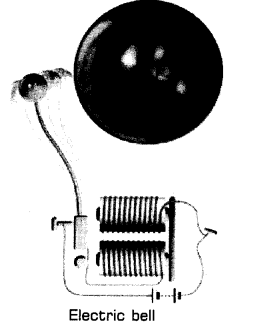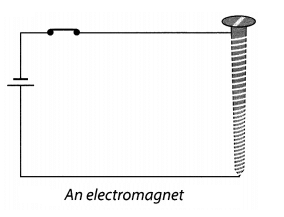Class 7 Science Chapter 10 Question Answers - Electric Current and Its effects
Q1. If cells are placed side by side. Then, how are the terminals of the cells connected?
Ans: If cells are placed side by side, then with the help of some connecting wires, the positive terminal of one cell is connected to the negative terminal of other to produce a combined power of all cells which can be called a battery.
Q2. Explain the following.
(a) Copper and aluminium wires are usually employed for electricity transmission. Explain the reason.
(b) Explain how does the resistance of a wire vary with its length.
(c) The tungsten is used almost exclusively for filament of electric lamp.
Ans:
(a) Due to the low resistance and strength of aluminium and coppers, both these metals are usually employed for the transmission of electricity.
(b) There is always an increase in the length of the wire with the increase in its resistance.
(c) Since tungsten has high melting point and high resistance. So, that is why, the tungsten is used exclusively for filament of electric lamp.
Q3. Explain how a battery can be constructed.
Ans: As we know that a battery is a combination of two or more cells and it can be constructed by placing cells property on cell holder in such a way that the positive terminal of one cell is connected to the negative terminal of other.
A piece of wire is connected to each of the two metal clips on the cells holder.
Q4. Electromagnets are better than permanent magnets. Explain why.
Ans: An electromagnet can be switched OFF or switched ON as desired and this is not possible in the permanent magnets. That is why the electromagnets are better than the permanent magnets.
Q5. If current is passed through a coil, does the pins cling to the coil?
Ans: When an electric current is passed through a coil, it gets magnetised due to phenomena of magnetic effect of current. When magnetic materials such as pins are placed near to it. It gets attracted by the coil or we can say that pins cling to the coil.
Q6. Distinguish between an open circuit and a closed circuit.
Ans: Difference between an open circuit and a closed circuit
Q7. Does the electric current have other effect except heating? Name it.
Ans: Yes, electric current have other effect except heating, i.e. magnetic effect of current.
When electric current is passed through a coil, there is a magnetic field developed around the coil or wire, if magnetic compass is placed near by, it deflects the magnetic needle.
Q8. If we connect more cells in the circuit, then what will happen?
Ans: If we connect more of cells in the circuit, then the nail will attract more pins. It is due to the reason that the current flowing through the wire wound on the nail will get increase which in turn will increase the strength of the electromagnet.
Q9. If the current flows through wire, does the wire behave like a magnet?
Ans: When the current flows through any wire, a magnetic field is developed around that wire or coil and it behaves like magnet. It can be analysed by placing a magnetic compass around the wire, it will show deflection of the needle.
Q10. State one measure to avoid overloading in an electrical circuit. Also mention the name given to a situation in which the live and the neutral wires accidently come in contact. Describe the role of a safety device in this situation.
Ans: Overloading can be avoided if too many appliances are not connected to a single socket. Short circuiting is a name given to a situation in which the live and the neutral wires accidently come in contact.
Electric fuse is a safety device. When a short circuit takes place or when overloading takes place, then the current becomes large and heats the fuse wire too much and thus, it gets melted and circuit breaks which prevents the damage of the wiring and electrical appliances.
Q11. Explain with the help of a diagram, how does the magnetic effect of electric current help in the working of an electric bell.
Ans: In order to ring the bell first of all we press the push button switch in order to ring the bell. So, when we press the switch, then the electric circuit of the bell is completed and a current passes through the coil of the electromagnet and it gets magnetised. The electromagnet attracts the iron armature towards itself.
So, as the armature moves towards the poles of the electromagnet, the clapper attached to it strikes the gong and produces a ringing sound. It implies that the bell rings.
When the armature moves towards the magnet, its contact with the contact screw is broken. Due to this, the electric circuit breaks and no current flows in the electromagnet coil. The electromagnet loses its magnetism for a moment and the armature is no longer attracted by it. The flat spring brings back the iron armature to its original position and the clapper also moves away from the gong.
As soon as the armature comes back and touches the contact screw the circuit is completed and current starts flowing in the electromagnet coil again. The electromagnet attracts the iron armature once again and the clapper strikes the gong again producing a ringing sound.
So, this process of ‘make and break’ of the electric circuit continues as long as we are pressing the switch. Due to this, the armature vibrates forwards and backwards rapidly each time making the clapper strike the gong. Thus, the clapper strikes the gong rapidly producing almost continuous sound.
Q12. Paheli took a wire of length 10 cm. Boojho took a wire of 5 cm of the same material and thickness both of them connected with wires as shown in the circuit given in figure. The current flowing in both the circuits is the same.
(a) Will the heat produced in both the cases be equal? Explain.
(b) Will the heat produced be the same, if the wires taken by them are of equal lengths but of different thickness? Explain. Ans:
Ans:
(a) No, the amount of heat produced in both the wires will be different because amount of heat produced in a wire on passing electric current depends on the length of wire and here length is different for both the wires.
(b) No, the amount of heat produced in the wire of same length but different thickness cannot be same because amount of heat produced in a wire also depends on the thickness of the wire.
Q13. Define a battery. Explain the arrangement of cells in a battery.
Ans: A battery is a combination of two or more cells in which cells are placed such that the positive terminal of one cell is connected to the negative terminal of the next cell. Many devices like torches, transistors, toys, TV remote controls, etc., use batteries. The cells are sometimes placed one after the other and sometimes side by side.
Q14. How many types of circuit are there? Describe.
Ans: There are two types of circuit
- closed circuit and
- open circuit.
(i) Closed-circuit: When the switch is in the ‘ON’ position and the circuit from the positive terminal of the battery to the negative terminal is complete then the circuit is said to be closed and the current flows throughout the circuit. Also the bulb glows in the closed circuit.
(ii) Open circuit: When the switch is in the ‘OFF’ position or the filament of the bulb is broken, the circuit is incomplete and it is said to be an open circuit. No current flows through any part of the circuit.
Q15. What type of wire is used for making electric fuses?
Ans: Wires made of some special materials that melt quickly and break when large electric currents are passed through them are used for making electric fuses. For example, alloy of lead and tin.
Q16. When does the current flow throughout the circuit? Explain.
Ans: When the switch is in the ‘ON’ position, and the positive terminal of the battery is connected to the negative terminal of the battery through wires then the circuit is said to be closed and the electric current flows throughout the circuit.
Q17. Why are wires of different materials and different lengths and thicknesses used?
Ans: The amount of heat produced in a wire depends on its material, length and thickness. Thus for different requirements, the wires of different lengths and thickness and materials are used.
Q18. What is an electromagnet?
Ans: A coil that behaves like a magnet when electric current is passed through it and loses its magnetism when the supply of electricity is broken is called an electromagnet. It is a temporary magnet made by coiling wire around an iron core; when current flows in the coil the iron behaves as a magnet. Electromagnets can be made very strong and can lift heavy loads.
Q19. What do you mean by overloading of an electric circuit? State two measures to avoid overloading.
Ans: The current flowing in domestic wiring at a particular time depends on the power ratings of the appliances which are being used. When a number of appliances are switched on at the same time, they take out an extremely large amount of current. This is called ‘overloading the circuit’. Now due to an extremely large amount of current flowing through them, the copper wires of household get heated to a very high degree and a fire may be started.
Two measures to avoid overloading are following:
- Too many appliances should not be connected to a single socket.
- Many electrical appliances of high power rating should not be run at the same time.
Q20. Explain construction of a simple electromagnet with a labelled diagram.
Ans: An electromagnet act on the principle of magnetic effect of the current. The coil of wire wound around an iron bar behaves like a magnet when electric current flows through it. When electric current is switched off, the coil generally loses its magnetism.
To construct an electromagnet, take a big iron nail or a big iron screw. Take a long piece of insulated copper wire and wind quite a few turns around the nail. Connect the ends of the wire to the terminals of a battery through a switch as shown in Fig..

Place some pins on or near the end of the nail. Now switch on the current. You will observe that pins cling to the nail. Now switch off the current. You will observe that pins no longer get attracted to the nail.
Q21. When does an electric short circuit occur? What harm can it do?
Ans: When the plastic covering of both live wire and neutral wire removes due to wear and tear, these two wires come in contact with each other. Since, the resistance of neutral wire is very low, excessive current flow through the wire in a short time which heats the wire to a great extent. This can result in fires. Another reason of short circuiting is connection of many devices to a single socket. This can also lead to excessive flow of current.
|
112 videos|286 docs|28 tests
|





















